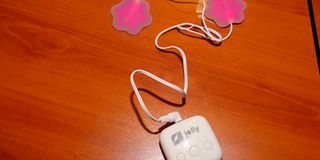Innovative device that alleviates menstrual pain

Jolly Device Board Member, Dr Jane Wavinya.
What you need to know:
- The device has leads connected to sticky pads called electrodes. To relieve pain, you attach the pads directly to your skin and turn the device on.
- The pads will deliver small electrical impulses to the area in pain.
When menstrual periods knock, some women crawl into a ball on all fours to try and ease the spasms of pain that come uninvited. Others prefer baring their bellies and laying on a cold floor while others tightly snuggle their hot water bottles.
And then there are sick leaves and unaccomplished targets because of inability to work, and for most, pain killers are the way to go, but some of the pills have side effects. But a new device that lowers menses pain has come in handy for hundreds of women and girls who have had to put up with heart-renting pain.
When Jacinta Nzyuko, an Embakasi resident, attached the electrodes of the device on her lower tummy, it gave vibrations that felt like a massage. In less than 10 minutes, the pain had subsided. “I have been using it ever since,” she told Healthy Nation. Dubbed Jolly, the device is a transcutaneous electric nerve stimulator that relieves period pain.
Peter Arina, a health informatics expert based in Nairobi and one of the innovators of the device, says watching his friend struggle with period pain gave him chills, and as much as he sympathised with her, it gave him an urge to find a solution.

The Jolly device
“The device has leads connected to sticky pads called electrodes. To relieve pain, you attach the pads directly to your skin and turn the device on. The pads will deliver small electrical impulses to the area in pain,” expounds Mr Arina, who is also the chief executive and co-founder of Swift Wellness, which started distributing the gadgets last November.
The electrical impulses can reduce the pain signals going to the spinal cord and brain, which may help relieve pain and relax muscles. They may also stimulate the production of endorphins, which are the body's natural painkillers.
“Depending on the pan impulse, the client regulates the impulse on the device,” he says.
He reveals that the device’s working mechanism is inspired by a science called gateway control theory, which dictates that in the human body, external impulse is given priority than internal impulse. During menses, the pain from the menstrual periods is the internal impulse, and it travels all the way to the brain.
When you place the electrodes and the impulse transmission starts, the external impulse is sent to the brain, which forces it to focus on the external impulse, thereby reducing pain from the abdomen.
Before he invented the device, he first created a system that merges a patient’s data from all hospital systems ever attended, and for a change, he wanted to work on a project that directly touches on the human body.
In 2019, he went deep into research, trying to merge electrical engineering and medicine. Dr Jane Wavinya, a general practitioner at Karen Hospital, became a member of his team, and together they created a solution to menstrual agony, which in scientific terms is referred to as primary dysmenorrhea. “During menstrual periods, there are hormones produced called prostaglandins that cause pain. Pain is also caused by uterine contractions and ischaemia, which results from a mechanism where the blood vessels in the uterus constrict, reducing blood supply to the uterus,” says Dr Wavinya.
Women with a tendency to produce more blood clots, she says, are also pre-disposed to more pain because the uterus has to contract more to expel them. She explains that besides disrupting the pain pathway to the brain, the electrical stimulation also stimulates the production of endorphins, the feel good hormones, which relieve pain and boost your moods.
“We have sold 207 units so far. We have received orders in the evenings from clients who are stuck to their seats because of the pain. We have made deliveries at night, and we have had to deal with clients agitated because of pain,” says Mr Arina.
Dr Irene Onyimbo, a physiotherapist at Aga Khan University Hospital, says the mechanism used by the device is safe and similar to the devices they use to manage pain in physiotherapy.
“We use transcutaneous electrical nerve stimulation (TENS) technology to treat body pains,” she says.
Although it is safe for most people, experts recommend that pregnant women should avoid using TENS in the abdominal and pelvic regions while applying electrodes to the head or neck of people with epilepsy as this could induce seizures.
People with heart problems and those with another type of electrical implant should also avoid it. The duration of pain relief after using the TENS unit can vary. Some people may experience pain as soon as they switch off the device while others experience adequate relief for up to 24 hours. Children and teenagers under 16 are exempt from using the device, and it cannot be used under water.
The device, which comes with a manual, its electrodes and a charger, costs Sh3,500. Its battery lasts for six hours if used continuously and you have to charge it fully to use it. “Use it for 30 minutes, take an one-hour break, and use it again depending on your pain. Pressing on the M (mode) button, you can adjust the frequency depending on your pain. You can use it at work, working out, and even while sleeping,” says Dr Wavinya.



